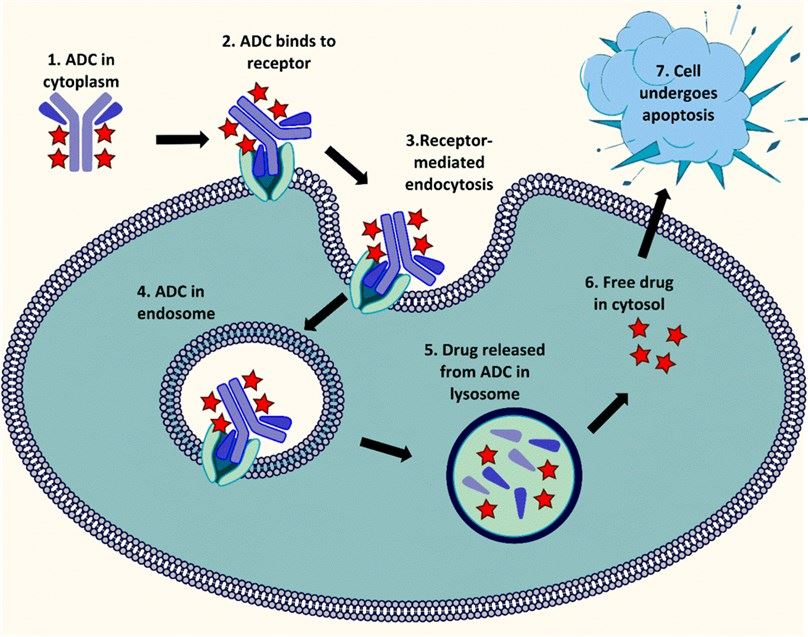Endocytosis & Internalization Potency Detection
Creative Biolabs provides a specialized service for global customers seeking to determine the endocytosis and internalization capabilities of their lead antibody candidates. Our service ensures researchers have access to high-quality data to assess the potential of their antibodies for therapeutic applications that rely on cellular uptake, such as intracellular delivery of payloads or targeted degradation.
The Significance of Endocytosis and Internalization Potency Detection
Therapeutic antibodies can trigger the internalization and degradation of cell surface receptors, a process with significant therapeutic and diagnostic potential. This receptor-mediated internalization enables targeted delivery of drugs, toxins, enzymes, or DNA into cells, making internalizing antibodies ideal vehicles for such applications. For antibody-drug conjugates (ADCs), rapid receptor internalization is crucial for effective and cell-specific drug delivery. While internalizing antibodies generally exhibit shorter half-lives than those targeting soluble antigens, this is likely due to their preferential receptor-mediated internalization over Fc-mediated recycling at low doses.
 Fig.1 ADC-mediated drug delivery mechanisms.1
Fig.1 ADC-mediated drug delivery mechanisms.1
Our Endocytosis and Internalization Potency Detection Service Packages
Creative Biolabs provides two distinct assay formats tailored to specific research goals, allowing researchers to delve deeper into the intricacies of antibody-mediated cellular uptake. To comprehensively investigate the receptor/antibody internalization mechanism during the early stages, we have introduced a range of cutting-edge techniques, which include:
| Creative Biolabs leverages extensive experience in whole-cell based phage display to isolate internalizing antibodies against a wide range of cell surface receptors, including EGFR, NTRK2, CTLA-4, HER2, CD20, CD3, CD59, transferrin receptor, and CD33. Our refined methodologies minimize the selection of non-receptor-specific internalizing phage particles and effectively distinguish between receptor-binding and receptor-crosslinking phage. | Internalization of antibodies into acidic endosomes and lysosomes creates a distinct pH gradient. We can track internalization activities using pH-sensitive dyes conjugated to antibody candidates. These dyes are cell-impermeable when unconjugated, minimizing background noise. This approach, utilizing cell imaging or flow cytometry, provides a sensitive and specific method for detecting antibody internalization. |
|
|
| An alternative approach involves labeling the targeted receptor with a small enzyme fragment and the endosome surface with its complementary fragment. Upon receptor internalization, these fragments co-localize within the endosome, reconstituting an active enzyme. This enzymatic activity, detectable with an appropriate substrate, serves as a sensitive and indirect indicator of antibody-receptor internalization, providing a rapid and straightforward assay. | Creative Biolabs maintains a collection of GPCR stable cell lines engineered for high-throughput screening of internalizing antibodies. These cell lines, expressing GPCRs fused with tGFP, allow for facile monitoring of antibody-induced internalization using flow cytometry. We also offer a diverse library of stable cell lines expressing various membrane receptors, including GPCRs and ion channels, suitable for a wide range of functional studies. |
| Creative Biolabs has developed a high-throughput and efficient live-cell imaging-based internalization potency detection to screen internalized antibodies. This innovative assay enables real-time monitoring of live cells, providing detailed insights to support global customer projects. |
Featured Highlights
- Selective technologies for precise detection of candidates' endocytosis and internalization activity.
- A top-notch expert team assists with your meaningful projects.
- Comprehensive and customized services to satisfy your diverse needs.
- Results delivery in customers' desirable timelines.
FAQs
Q1: How can I determine the internalization potency of my antibody?
A1: Determining the internalization potency of your antibody can be achieved through various methods. These include flow cytometry to quantify the uptake of fluorescently labeled antibodies, microscopy techniques like confocal microscopy to visualize antibody localization within cells, biochemical assays to measure antibody or receptor degradation, and enzyme-based assays that indirectly monitor internalization by detecting the reconstitution of enzymatic activity upon receptor internalization.
Q2: What types of samples are suitable for this analysis?
A2: Creative Biolabs can typically analyze a wide range of samples, including purified antibodies, antibody-drug conjugates, and even whole cells.
At Creative Biolabs, our team of scientists is dedicated to supporting our clients' innovative research endeavors by sharing our expertise. For further information or to discuss your specific project requirements, please do not hesitate to contact us or submit an inquiry.
Reference
- Chen, Hao, et al. "Tubulin inhibitor-based antibody-drug conjugates for cancer therapy." Molecules 22.8 (2017): 1281. Distributed under Open Access License CC BY 4.0, without modification.
For Research Use Only.
